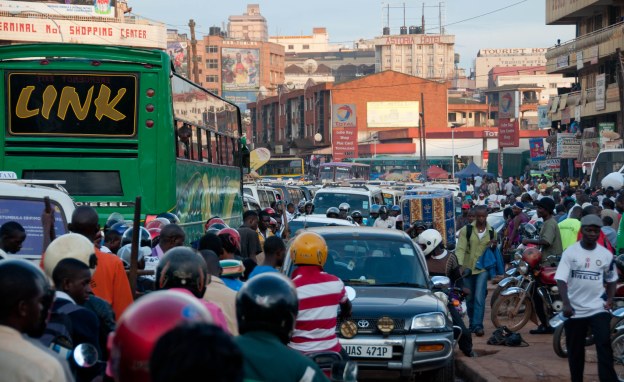Kampala, Uganda — Luwum Street has been one of the busiest motorized sections of Kampala city for years. Located just a block off the city’s main access; Kampala-Jinja Road, and connecting to the city’s main international gateway; Entebbe Road, Luwum often has bumper to bumper traffic from morning into late night.
Everyone appears to be in a hurry although everybody moves really slowly as the roads are jammed with cars, bodaboda taxi motorbikes, and human mules carrying heavy loads from one section to the other. Up to 90 percent of people in this area walk, yet the roads appear to have been designed for the few using motor vehicles. Moving on foot along this route is a tricky balancing act.
That is perhaps why, when the city planning authorities, mooted a plan to decongest the city, Luwum Street was top on the list. In the end, remaking the street has become a test case of Ugandan urban planning to favour the majority who either walk or cycle.
Kampala Capital City Authority (KCCA) is using Luwum Street to innovate a new city experience involving introduction of what are dubbed ‘pedestrian shopping streets.’
KCCA says the old Luwum Street of bumper-to-bumper motor vehicles will be redesigned into a car-less space with walking paths to encourage walking as a way of living healthy, wider green spaces for recreation, street benches and shades for tired shoppers.
Like many cities in the world, Kampala city’s public transport is highly polluted, congested and time/energy consuming.
In order to promote bicycling, walking and physical activity, cities and towns around the world are closing streets to cars and opening up to a variety of modes and uses. Using these temporary street closures, communities have safe and convenient opportunities for bicycling and walking.
Urban planning experts say half of all trips in Kampala are short and within cycling and walking distance with about two million people using public transport. Public transport continues to reflect challenges to city authorities and urban planners.
There are significant barriers within a city that discourages physical activity such as the presence of high volume, high-speed roads; safety concerns in street and side-walk design; poor air quality and lack of public parks.
Luwum Street faces all these challenges. But it is also no stranger to change. Historically it boasted the first shops in Kampala in the early 20th century and was renamed after a prominent Christian leader who was martyred during the Idi Amin reign of terror in the 1970s. But the coming change looks set to be the most dramatic and perhaps impactful.
Since April 2018, KCCA has been remodeling Luwum Street and its sister road, Namirembe Road. The two are in fact one 2km road, although the Namirembe section was so named possibly to indicate its direction to Namirembe Cathedral when it was constructed.
Together, Luwum and Namirembe literally cut through the centre of the city from north to south. From the north, the route carries all the traffic entering the city from the two main veins of Hoima Road with 40,000 vehicles per day and Gulu Highway with over 35,000 vehicles per day and the south Luwum Street is the main artery for cars going out of the city to the east along Kampa-Jinja Road with over 50,000 vehicles per day. Along the way they traverse some of the busiest motorized and human traffic locations in the city; two taxi parks, two main city markets and several bus parks.
The roads are also mostly lined with shopping malls, and the city’s main business hub; the Kikuubo area, and a few theatres. Throw in the hundreds of pedestrian that throng the area daily as bus or taxi passengers, traders, and shoppers and you have a true medley of moving bodies. KCCA wants to change that.
KCCA’s intervention is in line with the National Non-motorized Transport Policy whose primary objective is to increase the recognition of walking and cycling in transport planning and design. It revolves around provision of safe infrastructure for pedestrians and cyclists.
The Shs 4 billion project is funded by the government and other partners including the United Nations Environment Programme (UNEP) and UN-Habitat. It is being implemented as a pilot study to assess its efficiency in Kampala.
Under the plan, providing resources of walking and cycling in the city’s financial planning and developing and adopting universal design standards that provide for access to all sectors of the community will get more attention. The city will also improve regulation and enforcement to enhance safety for pedestrians and cyclists.
When The Independent recently visited the stretch, which takes about 20 minutes to walk, workers of Stirling Civil Engineering Ltd were busy marking some sections in the Bakuli area on one end of Namirembe Road to the north with green paint. On the northern end of Luwum Street, more workers appeared to be putting final touches on the pedestrian walkways. Work on the Luwum section started in November last year and was expected to last a month. But that was stretched and KCCA now says everything should be ready by March.
Anxious businesses
Everybody is anxious but not everyone is happy. As dust by the road construction workers billowed outside his shop on Luwum Street, Badru Kiberu, who sells watches, looked on sadly. He told The Independent that ever since the project started, business along the road has dwindled dramatically and traders continue to count losses.
“This project is good for pedestrians but not us,” he said.
He said business on Luwum Street came mainly from car driving shoppers who prefer to park and shop and not the hordes of traders that crowd the Kikuubo and Namirembe section that KCCA appears to be targeting.
“Most of our customers used to be people who don’t want to go downtown but want to make a brief stop near our shops, buy a shirt or watch and go away,” he told The Independent. He does not see customers returning even after the opening of the ‘pedestrian shopping street’ – because cars will no longer be allowed in.
His neighbour, Brenda, a dealer in wedding clothes, says the project has ruined her.
“Customers cannot come here anymore because the city has a problem of parking space,” she said, “For pedestrians, it is okay but for customers who come to specifically buy stuff here, it is difficult.”
But when The Independent spoke to KCCA officials about the worried traders, they said the traders will come to love the project when it is completed this March.
The KCCA Executive Director Andrew Kitaka told The Independent on Feb. 14 that “by March 2020, residents of Kampala will enjoy shopping without worrying about speeding bodas and taxis.”
“And we are certain businesses will record high sales with more people shopping,” he said.
He said the authority chose this stretch because it is a high-density pedestrian area but it lacked designated space for people to walk and shop.
“Shopping along this corridor was unpleasant and as a result, businesses lost out on potential customers, as many opted not to shop in this unsafe environment.” Kitaka said, “This will change soon.”
In a recent post on KCCA’s Facebook page, Kitaka said Kampala borrowed the design from cities like Jerusalem in Israel where part of the city’s business district was redesigned in 2011 to only be accessible by light rail. No cars are allowed in the redesigned area and the number of shoppers increased because it was more accessible, and the shopping experience more pleasant.
Kitaka says even in Jerusalem, business owners had earlier objected to the project during the construction phase but realized unmatched profits and they are big supporters of pedestrian shopping streets.
“The business community should not worry that this will negatively affect their business. Actually, it will enhance their business through reduction of congestion, improved safety/security for all and creation of easier access to the area for pedestrians.”
Peter Kaujju, the KCCA publicist told The Independent on Feb. 14 that the authority is certain there is going to be more traffic of pedestrians along the redesigned route and traders will get more business. Instead, Kaujju says, KCCA is more concerned about the street furniture, street lights, benches, flowers and grass being installed.
“We appeal to business owners, customers, vendors and city residents to support the initiative and protect them all,” he said.
KCCA says a road user satisfaction survey published by the Uganda Road Fund in October last year noted how construction of designated walkways topped the priorities that pedestrians wanted in the city. It was ahead of other priorities like fixing potholes (12%), dust control (11%), construction of more pedestrian crossings (8%) and better road designs (6%).
Happy cyclists
Amanda Ngabirano, a cycling enthusiast and lecturer of urban and regional planning in the Department of Architecture and Physical Planning at Makerere University says she is happy that KCCA has finally come up with a project that targets the majority of city residents.
Ngabirano told The Independent that for this project to succeed there is need for sensitization of the residents so they change their behaviour when it comes to road usage.
“This should be the responsibility of KCCA but also the Traffic Police will have to come in and enforce the regulations,” she said.
Ngabirano wishes KCCA could fast-track the extension plan so that the entire city can have the same network she sees along this stretch.
She says a network that, for instance, makes it easy to walk or cycle from Kalerwe to Old Kampala unhindered would go a long way in making life easier for Kampala’s pedestrians and cyclists.
Charles Waako, a bodaboda cyclist thinks this is positive development for Kampala city which should be embraced by everyone. His only worry also is that the demarcation of the roads for motorists, cyclists and pedestrians might not work unless KCCA sensitizes first and then tries to enforce the laws.
Waako says Ugandans always behave like they are in a hurry.
“I will not be surprised to find bodaboda cyclists in the pedestrian section and pedestrians in the section for the motorcycles,” he said. But KCCA says route guides and traffic signage will be displayed at junctions and all across the route. The authority says it intends to work with its enforcement team and the police to ensure businesses operate smoothly and in accordance with set regulations.
Non-motorized transport includes all forms of movement that do not rely on an engine for mobility. It is recognized as a valuable component of the transport system and the environment due to the various benefits it holds.
Kampala’s aim is to join cities that are realizing the benefits of non-motorized transport and are designing policies, programmes and projects to accommodate non-motorized transport needs.
The city authority says it is also planning to work with a vendor to provide bicycles or scooters for hire along this corridor, which has special bicycle lanes.
Kitaka said successful implementation of the non-motorized pilot project will de-congest this part of the city and lead to wider coverage of the city with such routes in future.
“In addition, walking and cycling are beneficial to the population and have been proved to be an effective control of non-communicable diseases,” he says.
Motorized transport is associated with high fuel prices, air pollution, and traffic congestion which force the government to invest in correcting the damage; including the high environmental impact costs. Cycling and walking, meanwhile, enhance mobility options, offer green transport, and boost the economy. That is the dream KCCA wants to become reality in Kampala.
ALL AFRICA










